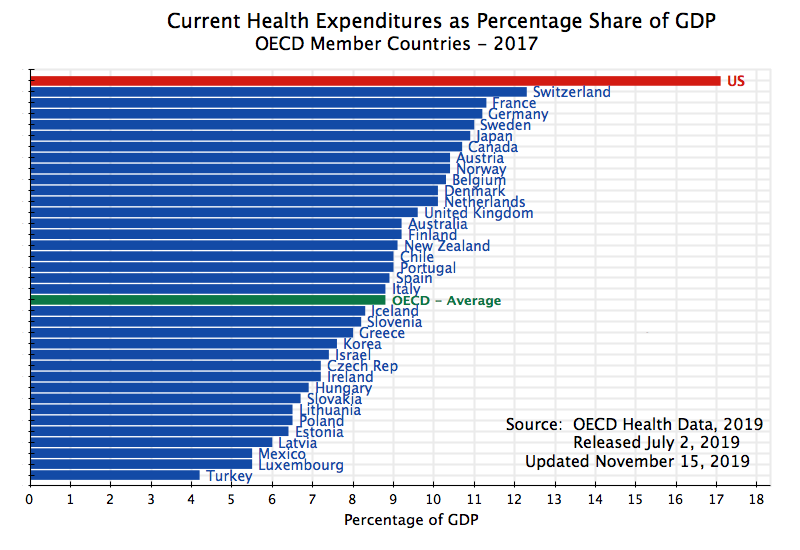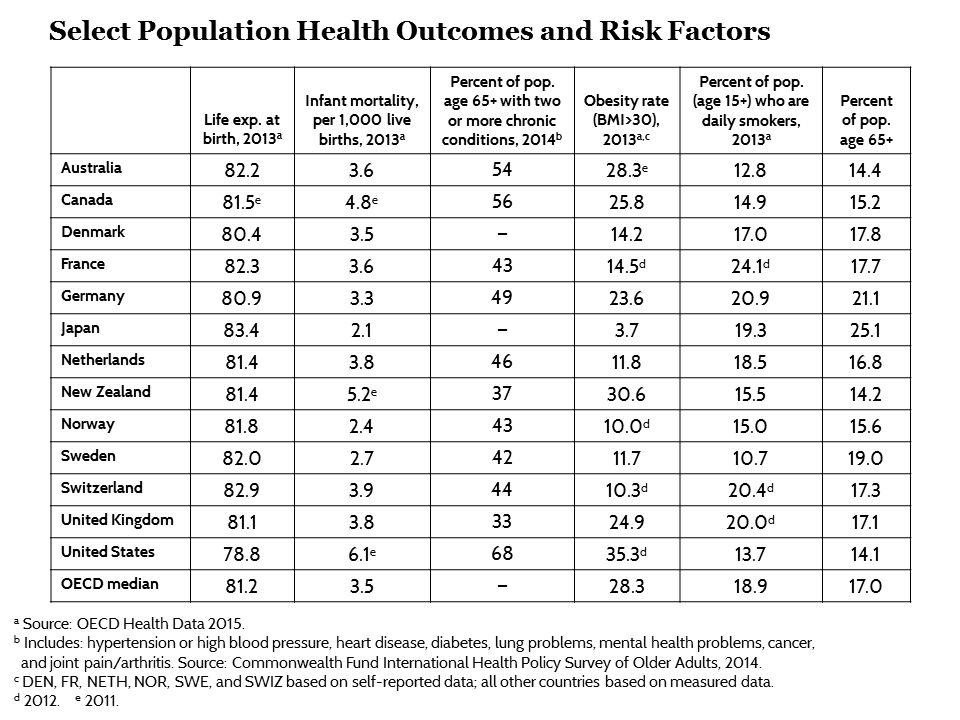Go straight to The Bottom Line

We can all relate to this issue. Sooner or later, virtually all of us will have to receive treatment for some sort of illness. In the meantime, it is clear that we are all paying, one way or another, for a healthcare system with major problems. The American healthcare system generates far worse outcomes at far higher costs than that of every other industrialized nation. (Look at the two charts presented below and the explanations that follow.)


The need to do something about health care is one thing that Republicans, Democrats and Independents generally agree on. But what needs to be done, exactly? Let’s consider some facts about the current state of healthcare in the U.S., and call them the three Cs:
- Coverage – too many are still uninsured: While the Affordable Care Act (ACA) of 2010, also known as Obamacare, reduced the number of Americans without healthcare coverage from 16.3% in 2010 to 9.1% in 2018, that still leaves over 29 million Americans without health insurance. Maybe you are asking yourself, if I have health insurance, why should I be concerned about people without coverage? The problem is that when the uninsured get sick, often with something that would have been preventable if they had access to regular checkups, they go to the emergency room where hospitals are required to provide treatment and where treatment is very expensive. If the uninsured patient cannot afford the treatment, the costs are absorbed by the hospital and you end up paying for their expensive emergency treatment through higher healthcare costs, insurance premiums and taxes. When coverage increases, costs go down, and as a bonus we get to live in a healthier, happier America.
- Cost – way above what other countries are paying: Healthcare costs in the US are the highest of any country in the developed world. In 2018 we spent 16.9% of our GDP on healthcare. The next highest was Switzerland at 12.2%. The UK spent 9.8%. The reasons US healthcare costs are so high include high administrative costs and inefficiencies of a system of independent healthcare providers, a fee-for-service payment structure for doctors that encourages excessive or unnecessary testing and treatment, and pharmaceutical companies that leverage the system for high drug prices.
- Care – far worse outcomes than other countries enjoy: For all this outrageous cost we must have the best, most effective healthcare in the world, right? Wrong. The US has the lowest life expectancy from birth among major Organization for Economic Cooperation and Development (OECD) countries. We also have the highest infant mortality rate, the highest rate of obesity and the highest percent of the population 65 and older with two or more chronic conditions. Not a particularly favorable return on our big healthcare investment.
What are the major parties planning to do to fix this?
Let’s take a look at both party’s platform statements, then dig a little deeper into what each party has to say about the others’ plan.

The Republican plan to fix US Healthcare
The Republican plan for US healthcare reform is summarized in the Republican party platform of 2016 (which was not updated for 2020).
- Restoring patient control and preserving quality in healthcare
- Protecting individual conscience in healthcare
- Better care and lower costs: Tort reform
- Advance medical research and development in healthcare
- Putting patients first: Reforming the FDA
- Advancing Americans with Disabilities
Restoring patient control and preserving quality in healthcare refers to the repeal of the Affordable Care Act (ACA) of 2010, also known as Obamacare, which the Republicans believe places undue burden on the medical industry and costs on the consumer. The Republicans have been promising a plan to replace Obamacare (for more than a decade), but as of this writing, no such plan has been disclosed. However, the party platform makes it clear that a replacement plan would be based on a competitive free market approach much like our current system. The Democratic argument against repeal of the ACA is that it would take us back to a time when insurance companies could refuse coverage based on pre-existing conditions, causing millions of Americans to lose coverage. Indeed, during the last two years of the Trump presidency, which has been hostile to the provisions of the ACA, and lax in enforcement of its rules, we have seen the number of Americans without healthcare coverage increase for the first time since 2010.
Protecting individual conscience in healthcare, the next plank of the Republican platform, means allowing healthcare workers, doctors, nurses, pharmacists, and organizations, to refuse to provide treatments or procedures that conflict with their faith or conscience without discrimination or penalty. The Republicans argue that no person or organization should have to provide a service that goes against their moral principles, particularly when it comes to abortion. Democrats see this provision as a slippery slope that will lead to discrimination of all types based on the healthcare provider’s faith, conscience, prejudices or whims. It is also seen as a backdoor attempt to defeat the established precedent of Rowe v. Wade, leading to a world where there are still abortions, but they are illegal, unregulated, and unsafe.
Better care and lower costs: Tort reform means making it harder to sue physicians and health providers for malpractice. Republicans maintain that tort reform would reduce frivolous lawsuits and reduce healthcare costs by reducing the insurance burden on physicians and reduce the need for doctors to practice defensive medicine by ordering excessive testing and specialist referrals. Democrats feel it will also make it much harder for people whose lives were severely impacted by bad medical decisions to receive the compensation they might need to lead a normal life.
Advancing medical research is a noble goal and a fundamental tenet of both parties. The Republican plan favors funding for private companies to develop medical products and treatments that will make a profit and thereby provide jobs and help the economy. The Democratic plan would favor funding research through established government science centers like the National Institutes of Health (NIH) and the Centers for Disease Control (CDC). They would also build on the foundation of the Obama Biden Administration’s Cancer Moonshot to find new cures and treatments for cancer and other diseases.
Reforming the FDA by reducing its regulatory powers is intended to reduce the financial burden and roadblocks to new medical device and drug development. The Republicans believe this will speed new products and treatments to the healthcare market and create new jobs in those industries along the way. Democrats feel the danger to this approach is that weakening the FDA’s mandate to assure only safe and effective medical devices and drugs are available to consumers will result in ineffective or even unsafe products will be pushed to market by the medical industry. It is worth remembering that the FDA’s power to regulate drugs was instituted in response to the unregulated sedative Thalidomide which caused tens of thousands of birth defects worldwide in the babies of women taking the drug.
Advancing Americans with Disabilities means supporting programs that allow disabled citizens to live a quality, dignified life, a goal supported by both parties.
The Democratic Party plan to fix healthcare
The Democratic Party plan for fixing healthcare is outlined in the 2020 Democratic Party Platform.
- Securing universal healthcare through a public option
- Bringing down drug prices and taking on the pharmaceutical industry
- Reducing healthcare costs and improving healthcare quality
- Eliminate racial, gender, and geographic health inequities
- Strengthening and supporting the healthcare workforce
- Investing in health science and research
Securing universal healthcare through a public option means building upon existing programs like the ACA, Medicare, Medicaid and the Veterans Affairs (VA) system to expand coverage to everyone who needs it, while preserving private insurance for those who prefer that option. In theory, the public option would provide competition to the private sector and force them to get costs under control. Republicans believe this is massive government overreach and will result in bureaucratic red tape, harm the thriving medical industry, and be akin to socialism. Democrats believe the public option would be more like the proven system used by the rest of the industrialized world (and that is already broadly accepted in the U.S. in the form of Medicare and Medicaid) and that profit taking by the medical industry is part of the problem with the current system. They also believe that in the classic free market world of supply and demand, too often the question of “how much would you pay to be healthy/stay alive?” the answer is “everything you’ve got.” This approach makes the public choice entirely optional, as opposed to the “Medicare for All” proposals championed by Bernie Sanders among others.
Bringing down drug prices and taking on the pharmaceutical industry means the government would take steps to curb anti-competitive practices used by drug companies to keep prices high and would negotiate drug prices for both the public and private options that are in line with prices for the same drugs in other advanced economies. Republicans believe this would stifle development of new medicines and that if the regulatory burdens imposed by the FDA were removed, pharmaceutical companies would drop prices on their own. Democrats believe drug companies would never drop prices on their own without a strong incentive to do so.
Reducing healthcare costs and improving healthcare quality would involve eliminating predatory surprise billing from out of network emergency room visits, instituting uniform medical billing and price transparency, and enforcing anti-trust to prevent mega-mergers in the hospital, insurance, and pharmaceutical industries that would raise prices for patients by undermining market competition. Republicans believe these practices would undermine the free market economy of the medical industry. Democrats believe the hospital, insurance, and pharmaceutical industries are already undermining the free market by gaming the system to monopolize control and engaging in anti-competitive practices that ultimately hurt the consumer.
Eliminating racial, gender, and geographic health inequities means addressing the underlying reasons for health disparities in some segments of the population due to lack of access to health resources like insurance, primary care and specialized care. Plans to protect native American health, secure reproductive health rights and justice, and protect and promote maternal health are also included here. Republicans have no specific statement on this topic in their platform except for their objection to the section on reproductive rights which promises to protect and codify Roe v. Wade and re-fund Planned Parenthood. Democrats argue that restoring funding to Planned Parenthood, which provides vital sex education, contraception, and preventive and reproductive health care for all women, especially the socially disadvantaged, would help reduce the number of unintended pregnancies and thereby also reduce the need for abortions.
Strengthening and supporting the healthcare workforce speaks to the spotlight shown on the healthcare support workers who are on the front lines of the COVID-19 pandemic, and how—despite the critical role they play in our society and our economy—these workers are often underpaid and lack access to paid sick days, health insurance, and other benefits critical for their own health and the health of patients. Republicans do not address healthcare workers specifically but support reforming labor laws, encouraging cooperation between management and workers. They also favor a Right-to-Work law and employee stock ownership plans to energize a free enterprise economy and feel minimum wage is an issue that should be handled at the state and local level. Democrats believe that all jobs in the healthcare economy must come with family-sustaining wages, good benefits, access to training and professional development, and the ability to join a union and collectively bargain. They further believe all employers funded by taxpayer dollars must pay their workers at least $15 an hour and protect workers’ rights to organize.
Investing in health science and research is supported by both parties as previously discussed, with Republicans favoring funding private companies and Democrats favoring funding public institutions and universities.
The Bottom Line
The public options have proved successful in almost every other industrialized nation on earth, but to some voters, they continue to feel somehow un-American. Keep the system essentially as it is – even though it costs much more and produces much lower quality health care than other countries experience – or try something different? You decide.